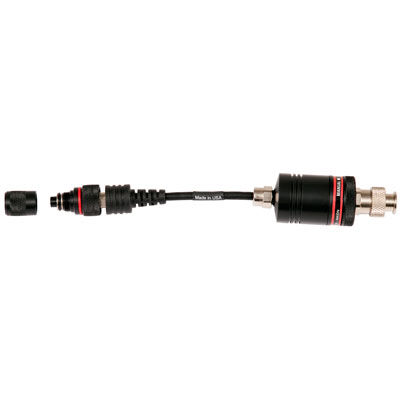TTL Converters and Optical TTL
Many photographers set the power of their strobes manually, changing the power for each shot. Or, alternatively, they keep the strobe on 1 power setting, and change the camera aperture to get the proper exposure.
A TTL converter is a device that automatically sets the exposure on your strobes when the strobes fire (flash). The strobes are connected to the TTL converter. With a TTL converter, most of the time you no longer have to worry about setting your strobe power
TTL converters are becoming more popular, and the recent versions can be highly accurate, especially for macro, or close-focus wide-angle photography. Many people with TTL converters still shoot their strobes in manual mode for wide-angle photography with a lot of water in the photograph, because it is more difficult for TTL to be accurate in these circumstances.
TTL originally meant "through the lens". Now it has taken on the meaning of a way to automatically set the exposure of an external strobe or flash.
Here are 4 different choices for TTL converters:
Buy an Ikelite dSLR housing. All of them come with a TTL converter inside the housing, which works with Ikelite strobes.
Buy an external Ikelite TTL converter. This can work with Ikelite strobes, and any Nikon dSLR housing - and works great.
Sea & Sea has an excellent Optical YS Converter built into newer housings (70D, D7100, etc). They also make an external TTL converter for dSLR housings. They run around $600. There are Nikon and Canon versions. A couple of the S&S housings also had the TTL converter build into the housing. There are different versions of the S&S TTL converter, make sure you get the correct one with your housing / strobe combination. Inon Z240 strobes usually will work well with S&S TTL converters, even though the converters are advertised to work only with S&S strobes. You can see my Inon Z240 settings with my S&S TTL converter. I recommend using the TTL converter with the YS-D1 strobes. This TTL converter will often also work in other housings such as Aquatica.
HeinrichsWeikamp, in Germany, usefd to make their own external TTL converters that work with many strobe-housing combinations. However, unfortunately they have stopped making these converters.
Optical TTL, aka sTTL
Some INON and Sea & Sea strobes, such as the Sea & Sea YS-D1, YS-01, Inon Z240, Inon D2000 and Inon S2000 have TTL ability without the need for a TTL converter. INON calls this feature sTTL, and some photographers are using it successfully for macro photography. The Sea and Sea YS-110A strobe also supports this feature, same with the YS-01 and YS-D1. Some housings, such as Seatool, Nauticam and Nexus housings, are starting to build housings that allow the flash to be used to fire strobes and use the optical TTL feature.
Optical TTL works because the strobe mimics the camera's pre-flash and internal flash. So your internal flash must be able to fire in order for this feature to work. Usually the internal flash will be blocked with tape over the housing to prevent backscatter, and a fiber optic cord will carry the light to the strobe sensor. This works well in many dSLR's and compact cameras such as the Canon G9 and G10. However, the Canon S95, S100, S110, G9, G10, G11, and G12 can't do TTL in manual mode, so you should use aperture or shutter priority mode to take advantage of the sTTL feature of your strobes.
To use INON S-TTL, simply set your INON strobe to the S-TTL mode, and hook up a fiber optic cable. With a Sea & Sea strobe, just set the strobe to TTL.
Is a TTL converter needed?
Many people shoot underwater successfully in manual mode. However, having TTL is a great convenience, especially for macro and sometimes close-focus wide angle.
You no longer need to worry about your strobe power settings, or your exposure, you can focus on more important things like composition, strobe placement, and selective depth of field. Once you have it, you would not want to shoot without it. Remember, even with the converter, you can also shoot with manual exposure control if you need it.
TTL or manual exposure underwater?
Even with my TTL converter, I'll switch to manual exposure sometimes. For example:
When photographing silvery fish underwater or other reflective objects
When there is sand that is easily over-exposed
For ultra close-focus wide-angle shots that are hard to evenly light
When I need to vary the strobe power between my strobes
Camera settings when using a TTL converter
- When shooting with an Ikelite or Sea & Sea TTL digital TTL converter, out of the 4 modes on your camera (M,A,S,P) - make sure you choose manual mode, so you can set the shutter speed and aperture yourself. The TTL converter will set the strobe power for you.
Further Reading

RECOMMENDED ARTICLES
SUPPORT THE UNDERWATER PHOTOGRAPHY GUIDE:
The Best Service & Prices on u/w Photo Gear
 Visit Bluewater Photo & Video for all your underwater photography and video gear. Click, or call the team at (310) 633-5052 for expert advice!
Visit Bluewater Photo & Video for all your underwater photography and video gear. Click, or call the team at (310) 633-5052 for expert advice!
The Best Pricing, Service & Expert Advice to Book your Dive Trips
 Bluewater Travel is your full-service scuba travel agency. Let our expert advisers plan and book your next dive vacation. Run by divers, for divers.
Bluewater Travel is your full-service scuba travel agency. Let our expert advisers plan and book your next dive vacation. Run by divers, for divers.































